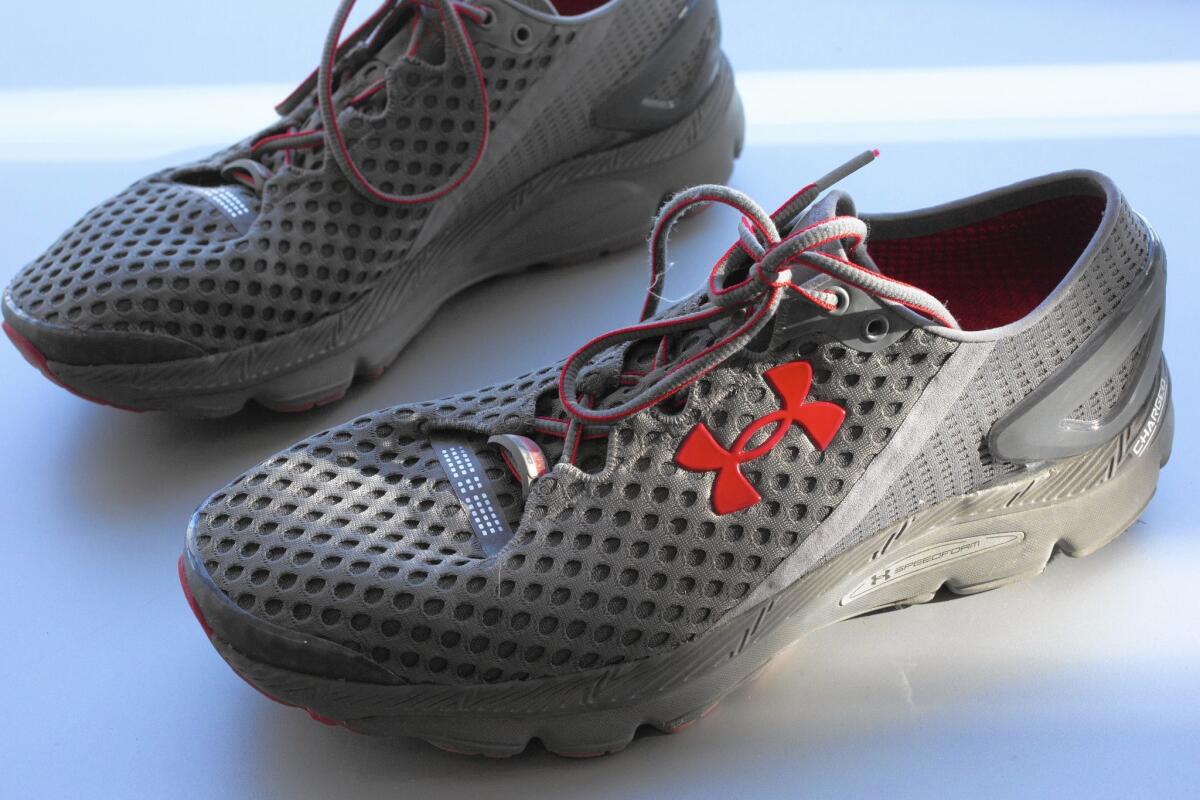The Download: 5 futuristic oddities from the weird world of wearable tech

“Smart textiles” are already starting to make their way into the fitness space. Above, a pair of Under Armour SpeedForm Gemini 2 running shoes. They contain an embedded chip to track exercise.
When futurists first began to predict the merging of man and machine, they surely couldn’t have predicted this: wearable furniture.
The Japanese-made Archelis is literally a wearable chair that surgeons can “wear” during long operating procedures. And there are more “wearable chairs” in the offing — Audi, for example, has partnered with Swiss start-up Noonee on a “chairless chair” that workers can wear while they assemble high-end vehicles.
The thought of a wearable chair might sound crazy, but it’s also a sign of where the super-hot field of wearable technology is taking us. If you thought the wearable tech space was only about smartwatches and activity trackers, here are just a few examples of new forms of wearable tech that are completely changing our notions of human-machine interaction.
MORE: Get our best stories in your Facebook feed >>
1. Robotic exoskeletons
The first generation of exoskeletons included those that were largely for purposes of rehabilitation or regeneration — a way for humans to regain the performance of a damaged limb, for example. But the next generation of exoskeletons promises to give humans super-abilities — such as the ability to lift a Mini Cooper off the ground with ease — or the ability to experience new sensations. The bionic exoskeleton built by Applied Minds, for example, enables users to feel what it’s like to age 40 years in a single day.
We could also see the arrival of military exoskeletons that give troops superhuman abilities as early as August 2018. The U.S. military’s Talos exoskeleton could be one way for troops to gain superhuman abilities during combat. The Talos “Iron Man suit” provides full bulletproof body armor, a helmet-based heads-up-display of the surroundings and enhanced capacity to carry more powerful weaponry while overcoming any obstacles in the environment.
2. Portable mind monitors
If you think about the current generation of human-computer interaction, it usually requires tapping on a keyboard or swiping a finger on a mobile device to get things to work. But what if there were a way to communicate with computers using only your thoughts? That’s the goal of the next generation of portable mind monitors that are worn strapped around the head, much like a virtual reality headset.
At UC San Diego’s engineering school, there’s a wearable brain monitor that you strap to your head that enables users to “type” their commands using only their brains. Of course, projects like these are still in the experimental stage, but some researchers say that these devices could become as popular as smartphones within the next decade. On the crowdfunding platform Kickstarter, for example, it’s possible to find similar types of projects from researchers who are already blending cutting-edge knowledge in neuroscience and computer science to create brain-computer interfaces.
3. Stealth wear
If, like most people, you’ve been concerned about your privacy and how much information might be being gathered about you without your knowledge by surveillance cameras, “stealth wear” could be the solution. The idea for stealth clothing is similar to the idea of stealth technology used by the military; in this case, you need to find the right reflective material that can block surveillance cameras and mobile tracking devices. Of course, if you actively fear being trailed by surveillance drones and want to go completely off the grid, it’s unlikely that donning a cool anti-drone hoodie is going to do much to dispel your paranoia.
4. Smart textiles and smart clothing
One of the stranger products at this year’s CES show last month was a smart suit from Samsung that comes embedded with NFC tags in the sleeves. With those magic NFC sleeves, you can unlock your smartphone or exchange business cards digitally when you shake hands.
And, if you happen to live in a heavily polluted area, you might want to consider the Diffus Climate Dress, which contains sensors that measure the level of carbon dioxide in the air. Depending on the level of carbon dioxide, the climate dress will trigger LEDs woven into the fabric to create a light show. Just imagine how the dress would fare in smoggy Beijing.
On a more conventional note, new “smart textiles” are already starting to make their way into the fitness space, where they can monitor the body’s performance potentially more accurately than the current range of activity trackers.
5. Wearable tech that runs on the human operating system
One of the surprise breakout hits of the CES show was TipTalk, a watchband from Samsung’s super-secret Innomdle research and development team that lets you make phone calls by sticking your finger in your ear. That means it’s possible to transform any “dumbwatch” into a “smartwatch” just by swapping out the watchband. The motion of raising your arm will accept an incoming call, while the watchband helps to transmit the sound vibrations through your finger into your ear by using body conduction technology. The human body acts as a way to send digital messages.
***
It’s clear that the merging of man and machine is leading to the formation of entirely new ways of thinking about the human body. At the Wyss Institute for Biologically Inspired Engineering at Harvard, there is research being conducted in fields such as mechanobiology and bioinspired robotics, both of which hint at the merging of the natural world and the programmable world. There are two basic paths for the future of wearable tech — either the machines will end up inside us, or we will end up inside the machines — but either way, the hybrid man-machine future is closer than we might think.
Dominic Basulto is a futurist and blogger based in New York City.
ALSO
How and when to install a rooftop solar system
Snapchat and Viacom strike a unique deal, hoping it’ll boost ad revenue for both
Mysterious ship helped keep California gas prices high, consumer advocate says






